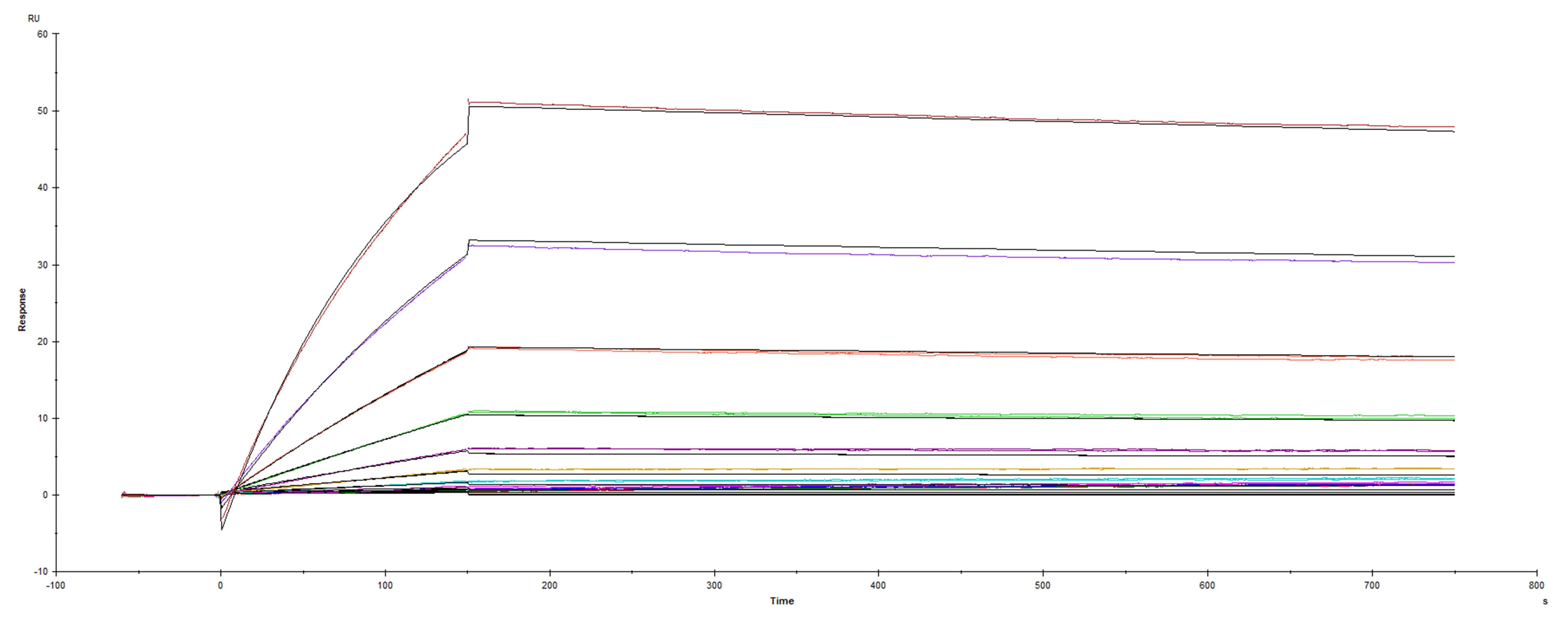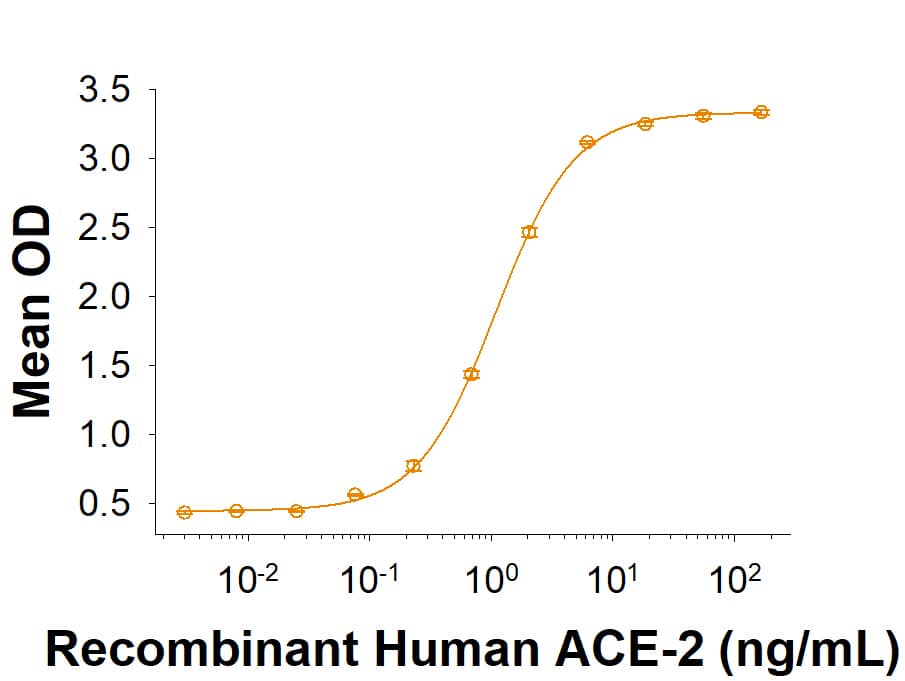Recombinant SARS-CoV-2 B.1.1.7 Spike GCN4-IZ His Protein, CF
R&D Systems, part of Bio-Techne | Catalog # 10796-CV
Alpha Variant (UK)

Key Product Details
Product Specifications
Source
Human embryonic kidney cell, HEK293-derived sars-cov-2 Spike protein
| SARS-CoV-2 B.1.1.7 Spike (Val16-Lys1211)(His69del, Val70del, Tyr145del, Asn501Tyr, Ala570Asp, Asp614Gly, Pro681His, Thr716Iso, Ser982Ala, Asp1118His)(Arg682Ser, Arg685Ser, Lys986Pro, Val987Pro) Accession # YP_009724390.1 |
GCN4-IZ | 6-His tag |
| N-terminus | C-terminus |
Purity
>95%, by SDS-PAGE visualized with Silver Staining and quantitative densitometry by Coomassie® Blue Staining.
Endotoxin Level
<0.10 EU per 1 μg of the protein by the LAL method.
N-terminal Sequence Analysis
Val16
Predicted Molecular Mass
138 kDa
SDS-PAGE
140-170 kDa, under reducing conditions.
Activity
Measured by its binding ability in a functional ELISA with Recombinant
Human ACE-2 His-tag (Catalog #
933-ZN).
Reviewed Applications
Read 1 review rated 5 using 10796-CV in the following applications:
Scientific Data Images for Recombinant SARS-CoV-2 B.1.1.7 Spike GCN4-IZ His Protein, CF
Recombinant SARS-CoV-2 B.1.1.7 Spike GCN4-IZ His-tag Protein Binding Activity.
Recombinant SARS-CoV-2 B.1.1.7 Spike (GCN4-IZ) His-tag (Catalog # 10796-CV) binds Recombinant Human ACE-2 His-tag (933-ZN) in a functional ELISA.Recombinant SARS-CoV-2 B.1.1.7 Spike GCN4-IZ His-tag Protein SDS-PAGE.
2 μg/lane of Recombinant SARS-CoV-2 B.1.1.7 Spike GCN4-IZ His-tag (Catalog # 10796-CV) was resolved with SDS-PAGE under reducing (R) and non-reducing (NR) conditions and visualized by Coomassie® Blue staining, showing bands at 140-170 kDa.Binding of ACE-2 to UK variant Spike protein (B.1.1.7) by surface plasmon resonance (SPR).
Recombinant SARS-CoV-2 B.1.1.7 (UK Variant) Spike protein (GCN4-IZ) His-tag was immobilized on a Biacore Sensor Chip CM5, and binding to recombinant human ACE-2 (933-ZN) was measured at a concentration range between 0.046 nM and 47.2 nM. The double-referenced sensorgram was fit to a 1:1 binding model to determine the binding kinetics and affinity, with an affinity constant of KD=0.6131 nM.Formulation, Preparation and Storage
10796-CV
| Formulation | Lyophilized from a 0.2 μm filtered solution in PBS with Trehalose. |
| Reconstitution | Reconstitute at 500 μg/mL in PBS. |
| Shipping | The product is shipped at ambient temperature. Upon receipt, store it immediately at the temperature recommended below. |
| Stability & Storage | Use a manual defrost freezer and avoid repeated freeze-thaw cycles.
|
Background: Spike
References
- Wu, F. et al. (2020) Nature 579:265.
- Tortorici, M.A. and D. Veesler (2019) Adv. Virus Res. 105:93.
- Bosch, B.J. et al. (2003). J. Virol. 77:8801.
- Belouzard, S. et al. (2009) Proc. Natl. Acad. Sci. 106:5871.
- Millet, J.K. and G.R. Whittaker (2015) Virus Res. 202:120.
- Ortega, J.T. et al. (2020) EXCLI J. 19:410.
- Wang, K. et al. (2020) bioRxiv https://www.biorxiv.org/content/10.1101/2020.03.14.988345v1.
- Isabel, et al. (2020) Sci Rep 10, 14031. https://doi.org/10.1038/s41598-020-70827-z.
- Tai, W. et al. (2020) Cell. Mol. Immunol. https://doi.org/10.1016/j.it.2020.03.007.1.
- Okba, N.M.A. et al. (2020) Emerg. Infect. Dis. https://doi.org/10.3201/eid2607.200841.
- Kidd, M. et al. (2021) The Journal of Infectious Diseases https://doi.org/10.1093/infdis/jiab082.
- Zahradník, J. et al. (2021) bioRxiv https://doi.org/10.1101/2021.01.06.425392.
- Davies, N.G. (2020) medRxiv doi:10.1101/2020.12.24.20248822.
Long Name
Spike Protein
Alternate Names
S Protein
Entrez Gene IDs
Gene Symbol
S
UniProt
Additional Spike Products
Product Documents for Recombinant SARS-CoV-2 B.1.1.7 Spike GCN4-IZ His Protein, CF
Product Specific Notices for Recombinant SARS-CoV-2 B.1.1.7 Spike GCN4-IZ His Protein, CF
For research use only
